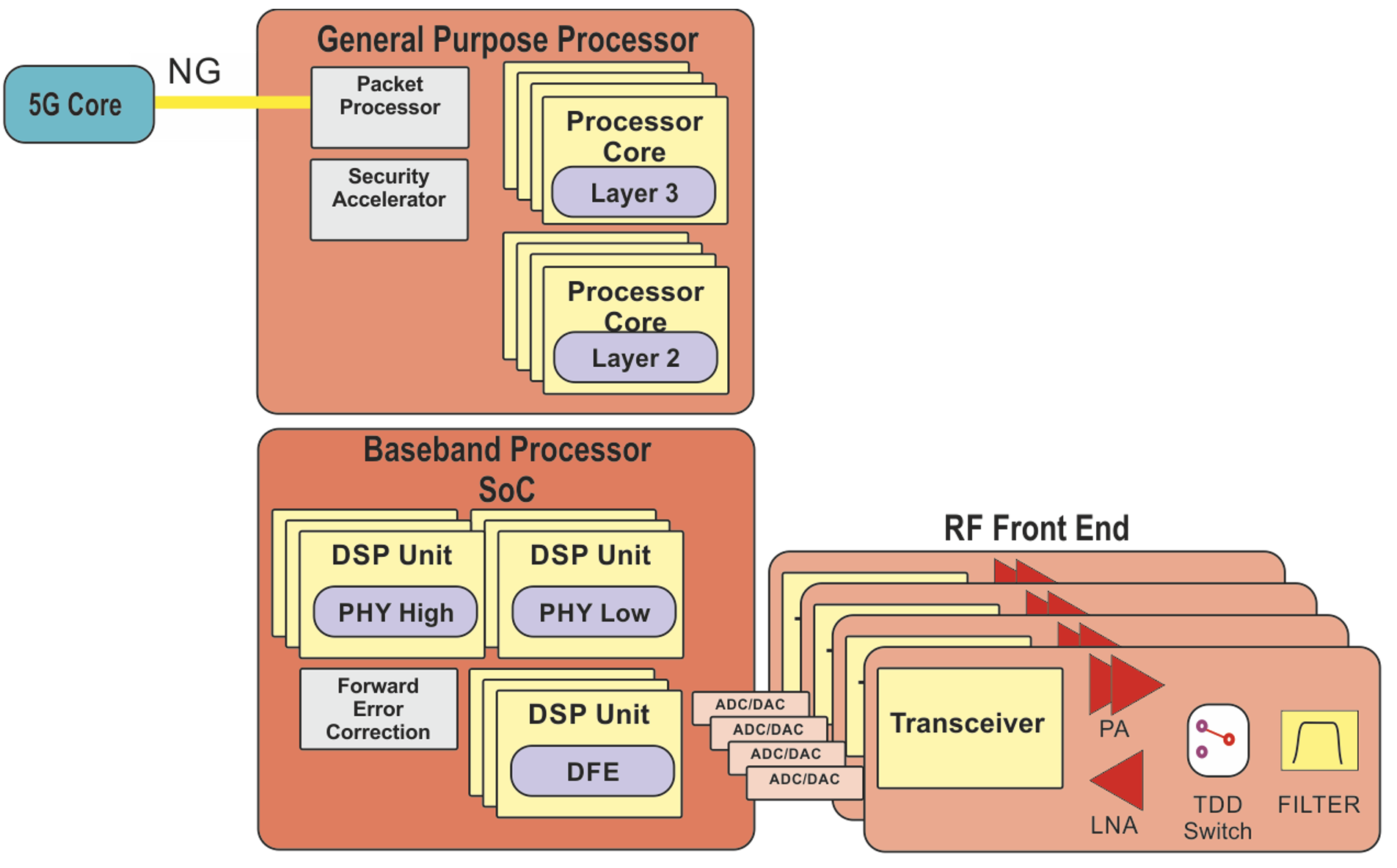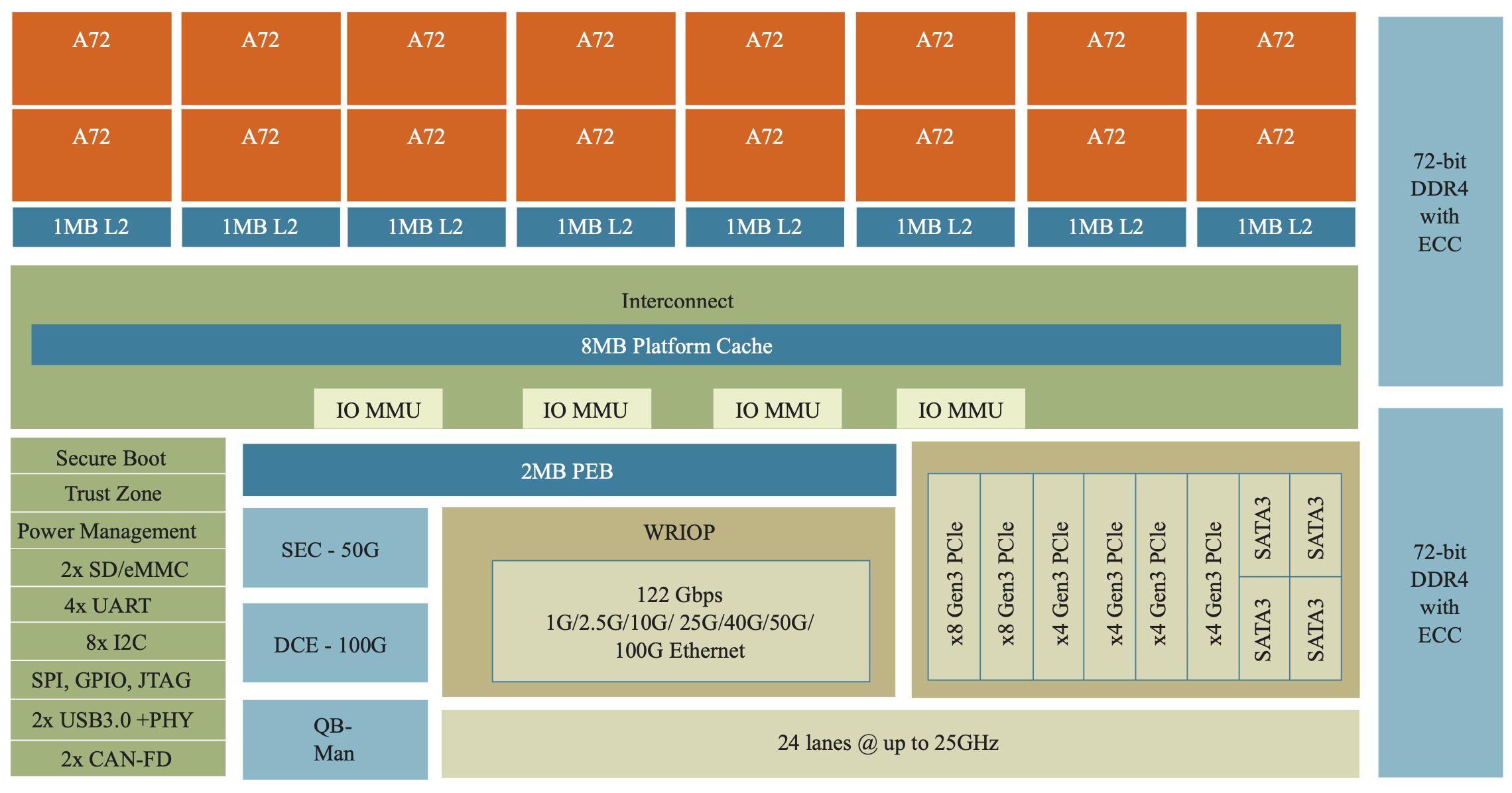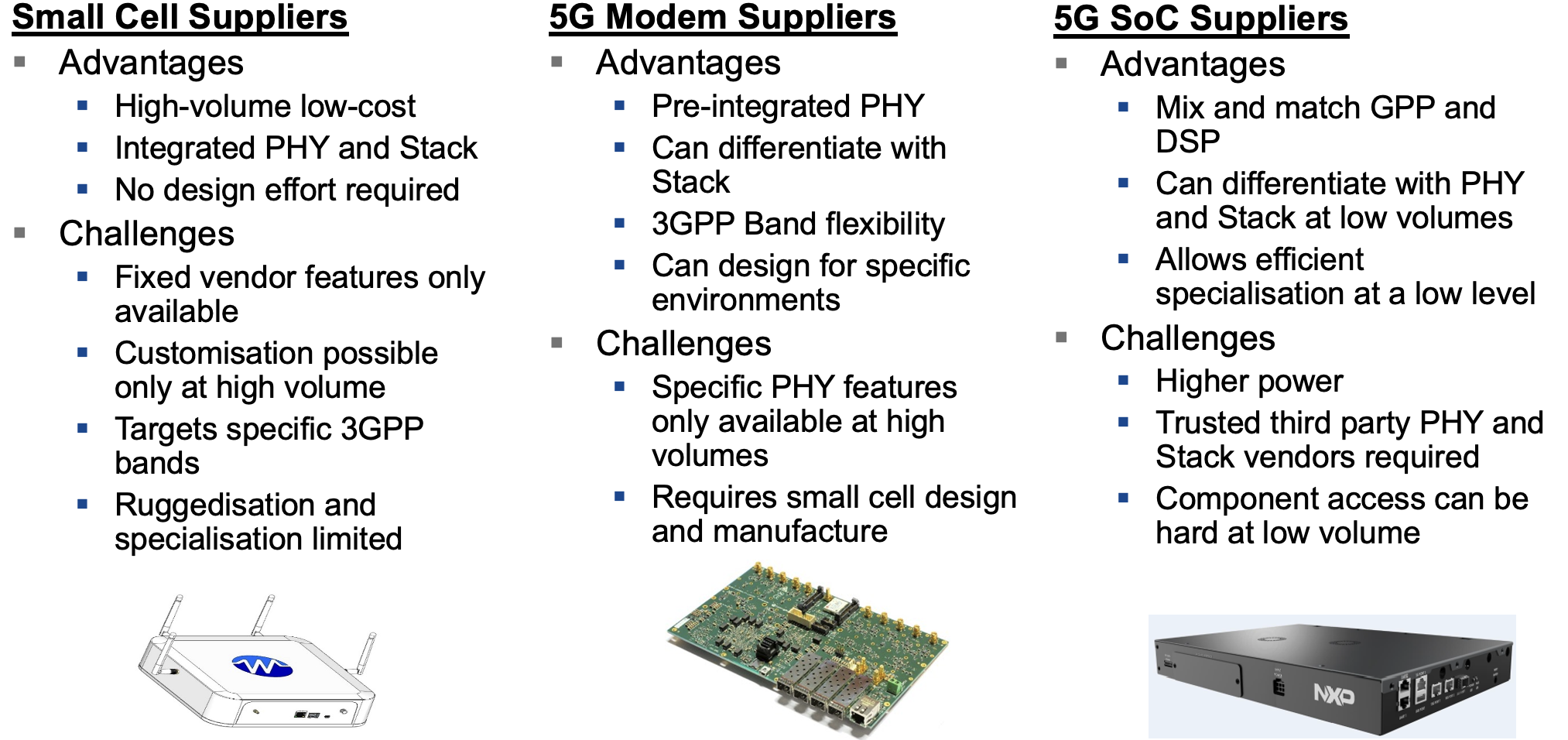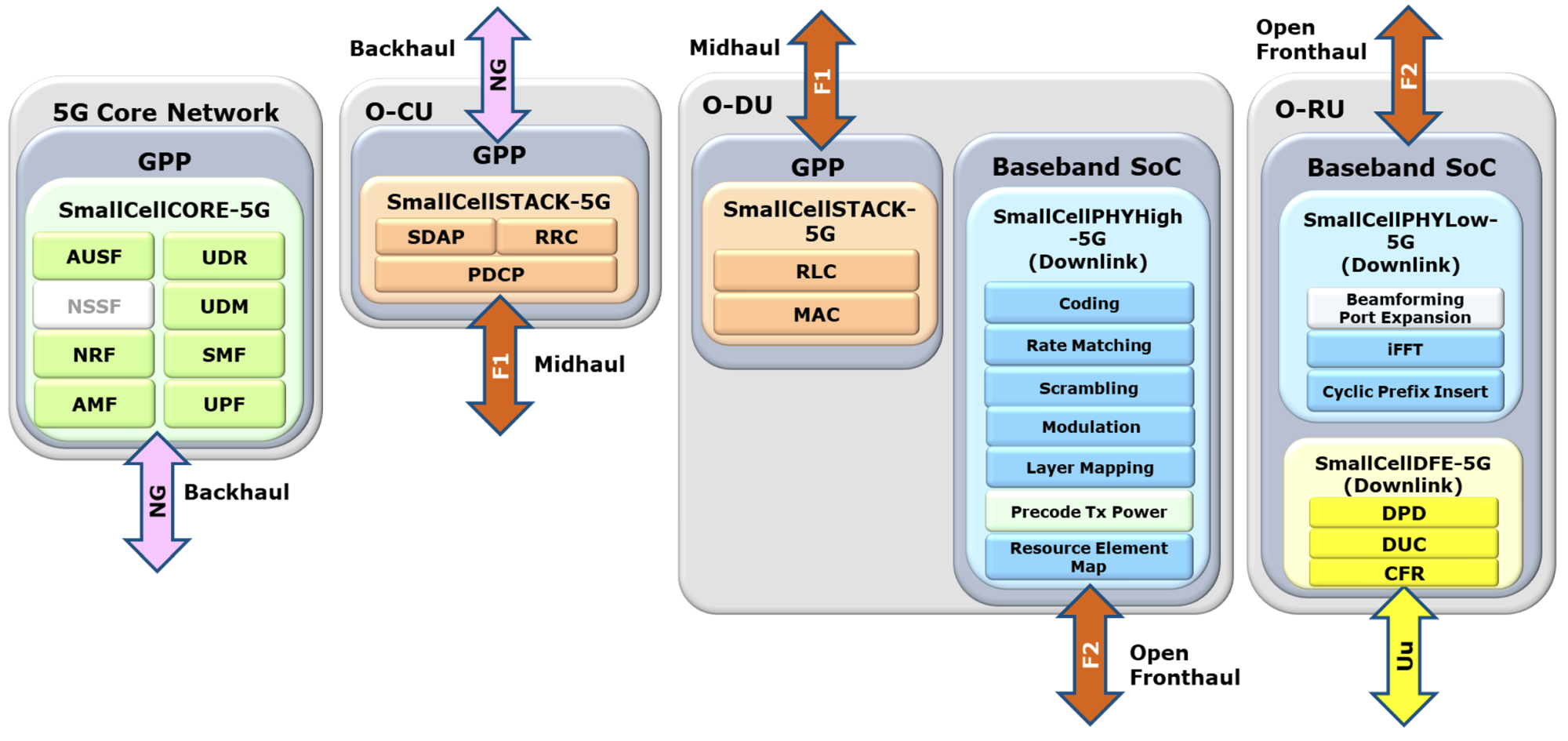To meet 3GPP specifications, a 5G New Radio (NR) implementation must meet demanding processing requirements and RF capabilities. Compared to LTE, this results in a need for higher performing, more flexible 5G NR hardware.
Looking at 5G’s technical challenges, we see the frequencies and spectrum supported now include a sub-6 GHz range, FR1, with bandwidths up to 100 MHz as well as a mmWave band, FR2, with bandwidths up to 400 MHz. This requires high bandwidth transceivers, resulting in interfaces such as JESD204 becoming faster and more expensive in power [Ref. 1]. A more integrated platform becomes preferable.
To meet the higher RF power demands and increased crest factor of 5G, IC designers are turning to more efficient technologies such as Gallium Arsenide for the RF power amplifiers (PAs). This amplifier class has highly non-linear characteristics with a memory effect, meaning that digital pre-distortion (DPD) techniques are required to maintain signal integrity. At higher bandwidths, the digital front end (DFE) that handles DPD requires a proportionate increase in processing performance.
5G NR introduces the cyclic-prefix orthogonal frequency-division multiplexing (CP-OFDM) and direct Fourier transform spread OFDM (DFT-s-OFDM) waveforms [Ref. 2]. These are important for increasing the spectral efficiency of 5G, but a consequence is that the physical-layer baseband processing is more complex than with LTE’s OFDM. Additionally, the forward error correction (FEC) standards of low-density parity-check (LPDC) and polar codes for improving throughput on noisy channels mean that there is a need for hardened processor accelerators to offload calculation.
5G also introduces disaggregated models to the network architecture. These enable such features as network virtualization in the core and low latency at the network edge. Architectures such as the O-RAN model, however, require flexibility to split the PHY and support of a high bandwidth fronthaul connection over time-synchronous Ethernet.
Components of a 5G base station
Which components of a 5G base station can meet these technical challenges? How do we build a system with the software flexibility to enable vertical markets to address the features they require, while keeping up to date with specification enhancements?
Figure 1 shows the basic functional components required to build an integrated gNodeB base station.

Figure 1. An integrated gNodeB includes a 5G Core, PHY, DFE and RF front end, as well as Layer 2 and Layer 3 packet processing.
Layer 2 and Layer 3 of the OSI model are responsible for the packet processing elements and have less strict timing requirements than the Layer 1 PHY. These can run on general-purpose processors (GPPs), usually comprising multiple Arm or Intel cores — the number of cores scaling with the cell throughput required. Packet accelerators for connectivity and security on the backhaul help processor offload to reduce power and improve throughput.
The baseband PHY (Layer 1) requires a time-deterministic architecture where the multiple signal processing blocks are better suited to dedicated digital signal processor (DSP) units, which also improves efficiency. Again, throughput, bandwidth, carrier count, and number of antennas determine the number of DSP units required. In the high-PHY, offloading the Forward-Error Correction (FEC) significantly reduces the DSP resources required by the PHY.
At the DFE, more DSP resources are required for digital filtering, up/down conversion, and RF transmit power improvement techniques such as Crest Factor Reduction (CFR) and Digital pre-distortion (DPD). Tight integration with the digital transceivers (ADCs and DACs) is required, which can be on-chip or connected externally over an interface such as JESD.
The RF analog front end comprises an RF transceiver to convert the analog baseband signal to the required over-the-air band, a power amplifier (PA) to provide the required gain for the cell coverage, a low-noise amplifier (LNA) to recover the mobile signal, and associated filtering to ensure emission mask compliance and prevent blocking signals affecting reception. Time-Division Duplex (TDD) requires a transmit/receive switch activated on frame boundaries under the control of PHY software. The PAs and filters are band-specific, and it is common for equipment to have a personality module to address specific 3GPP bands.
Software components
Figure 2 shows in more detail the algorithms and functionality performed by the software components identified in the previous section.

Figure 2. Software components of an integrated gNodeB perform functions that can be distributed in different locations.
This architecture lends itself to various partitions across the dedicated processing elements, GPP and baseband SoC, to maximize efficiency and scalability. The stack and the PHY use the 5G Femto Application Platform Interface (5G FAPI) defined by the Small Cell Forum, which can also run over Ethernet. 5G FAPI physically separates the GPP and baseband SoC functionality. This lets integrators mix and match PHY and stack solutions or add baseband SoCs to increase the number of MIMO layers.
Beyond the integrated small cell, a disaggregation model such as O-RAN, shown in Figure 3, lets network architects physically locate 5G network equipment in appropriate environments. For example, a centralized unit (CU) can perform Layer 3 processing with a general-purpose processor (GPP) can run closer to the core network, deployed in server type equipment.
The CU can support multiple distributed units (DUs) that run Layer 2 on a GPP and high-PHY on a dedicated baseband SoC with FEC accelerators. These units can be deployed either centrally or close to the radio sites, which in turn determines whether the equipment is based on plug-in cards to server equipment or is a custom outdoor cabinet unit.
A DU can support multiple radio units (RUs) and can reduce only the RF and low-PHY elements, which run on baseband SoCs or FPGAs. RUs minimize size and power, which supports installation at sites with limited access or reduces cell site rental costs. This allows more units to be deployed for densification, at reduced cost, while also supporting a mix of operating bands and throughput at different sites.
Pick the processors
5G requires higher processing performance than LTE. At CommAgility, we looked at the differing requirements for processors in a gNodeB. Doing so helps us to decide which tasks can run on a GPP and which need dedicated DSPs.
Physically compact hardware meets the requirements of private networks, which have space and weight limitations. Minimizing power consumption avoids excessive heat dissipation. All such decisions come with cost constraints.
What does these requirements mean for hardware designers? In practice, the best answer may well be a System on Chip (SoC), that offers GPP cores from Arm or Intel, specialized DSP capabilities, off-load accelerators, and on-chip memory and peripherals.
We chose processors with Arm cores. Our gNodeB development platform uses NXP’s LX2160A Layerscape communications processor, which includes sixteen Arm Cortex-A72 cores optimized for L2/L3 packet processing. The LX2160A also provides 8 MB L2 cache, and high-performance data path accelerators and peripheral bus interfaces including PCIe Gen3 and Ethernet up to 100 Gb/sec (see Figure 4).

Figure 4. NXP’s LX2160A SoC includes 16 Arm Cortex-A72 cores, 8 MB L2 cache, and multiple interfaces.
The development platform also includes an NXP LA1200 Layerscape Access baseband processor, which provides high performance from its vector-signal processing architecture (VSPA) vector engines, delivering more than 1 TFLOP. The LA1200 is specifically optimized for 5G NR, providing the DSP and hardware acceleration needed for compact, power-efficient designs.
Working with such highly-integrated SoCs can make you feel that you’re introducing excessive complexity. To overcome this, choose a silicon manufacturer who provides suitable software tools, such as real-time monitoring and debug, virtualization, and software management. Such tools can help developers cut time to market and make sure they can take full advantage of the flexibility offered by the SoCs.
System-level options
When looking at how to build your small cell, consider these starting points at various levels of integration: small cell suppliers, 5G modem suppliers, and 5G SoC suppliers. Each have advantages and disadvantages, as Figure 5 shows.

Figure 5. Each of these three approaches to building a gNodeB has pros and cons, depending on the application requirements.
The approach which works best will depend on the volumes of sales involved, and the nature of any specialization required. For example, small cell suppliers are unlikely to support all the features of every 3GPP release of the 5G specification. Ruggedization, to meet the demands of harsh environments, may also be impossible or limited.
Alternatively, beginning with an SoC supplier allows designers to achieve a bespoke product with a high degree of specialization, but means that trusted third-parties must be found for specific components, particularly when supporting uncommon RF bands. This can be complicated and add risk and development time to a project.
For many applications, the middle ground of 5G modem suppliers is a good compromise. However, this does mean that the features remain constrained by the modem manufacturer –- it’s only at high volumes that these can be modified.
To minimize costs, risk, and development time, you can start with an off-the-shelf reference platform. Once a system has been fully specified and proven, you can optimize the hardware design before production.
5G requirements
5G NR, established in 3GPP Release 15 and expanded in Release 16, introduces key improvements over LTE, including more efficient modulation, waveform optimization and scalable numerology – thus offering advantages such as low latency, faster speeds, and high reliability. This means there is a wide range of end use cases for which 5G will be attractive.
3GPP standards address specialized application areas such as mission-critical applications. Support began in 3GPP Release 13, LTE, in 2016 with Mission Critical Push-to-Talk, continued through Release 14 in 2017 with Mission Critical Video and Data. This trend continues to evolve in 5G, with Release 15 supporting legacy system interworking, and Release 16 supporting Public Warning.
Each application area, however, involves tens to hundreds of engineer-years of development effort, with varying degrees of complexity and commercial attractiveness. Not all equipment and integrated devices can or will support all features of every release.
For many applications, engineers need to migrate products from 4G to 5G, and then to customize them beyond the 3GPP 5G specifications. Private networks and specialized applications are predicted by many to potentially overtake operator networks in the market — for example, analyst ABI Research predicts that the private wireless networking market could reach US$16.3 billion by 2025 [Ref. 3].
Systems, therefore, must facilitate the migration to 5G, ideally by software upgrade or at least re-use. They also need sufficient flexibility to enable vertical markets to cherry-pick appropriate specification features. All equipment doesn’t need to be a superset of features, which would require more expensive approaches than are strictly needed.
Private networks or specialized application may use only some parts of the standards or may require algorithmic and protocol adaptations to deal with issues such as higher latency, longer range, higher Doppler shift, specific interference, or multiple parallel channels. For example, connecting from an aircraft traveling at typical cruising speeds of over 900 km/h and altitudes above 10,000 meters, creates a specific set of technical challenges. In particular, the network must support high speeds and large cell sizes as well as flight certification for airborne equipment.
Conclusion
Engineers designing and building a 5G gNodeB have several options. Picking the right design depends on your application — in particular, the functionality required, the financial constraints, and the expected volume.
A gNodeB’s will typically need higher processing performance than for previous LTE systems, but without excessive cost, size, or power consumption. In many cases, applications may also require a customized gNodeB, which goes beyond the capabilities of the 5G 3GPP standard, and a system that is flexible enough to meet evolving requirements.
To meet these needs, SoCs such as those with multiple Arm cores provide the necessary performance and capabilities. On the software side, the development effort required to build a customized implementation from the ground up is impractical and customizing an existing PHY and protocol stack is likely to deliver the optimum system in a reasonable timescale.
References
1. Lars-Peter Clausen, “Understanding JESD204B High-speed inter-device data transfers for SDR,” https://archive.fosdem.org/2017/schedule/event/jesd204b/attachments/slides/1549/export/events/attachments/jesd204b/slides/1549/jesd204_fosdem2017_lpc.pdf.
2. Bob Witte, “The basics of 5G’s modulation, OFDM,” https://www.5gtechnologyworld.com/the-basics-of-5gs-modulation-ofdm/.
3. Press release, “Nokia, Elisa join forces in Finnish private mobile networks push,” https://www.nokia.com/about-us/news/releases/2021/02/17/nokia-elisa-join-forces-in-finnish-private-mobile-networks-push/.
 Paul Moakes, PhD CEng MIET, is Chief Technology Officer at CommAgility. He has previously held positions at Motorola and Blue Wave Systems. He is co-inventor of two patents in the field of MicroTCA and AdvancedMC. He holds a PhD in Electrical and Electronic Engineering from Sheffield University and a 1st Class Honours degree in Electronic Communications and Computer Systems Engineering from Bradford University.
Paul Moakes, PhD CEng MIET, is Chief Technology Officer at CommAgility. He has previously held positions at Motorola and Blue Wave Systems. He is co-inventor of two patents in the field of MicroTCA and AdvancedMC. He holds a PhD in Electrical and Electronic Engineering from Sheffield University and a 1st Class Honours degree in Electronic Communications and Computer Systems Engineering from Bradford University.
